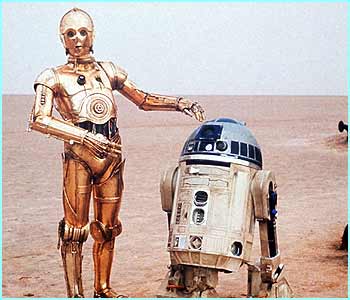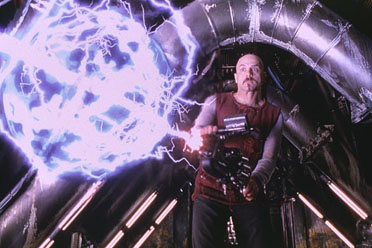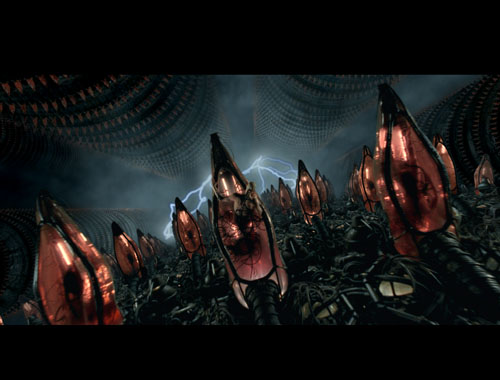A Brief History of Science Fiction Film Music
References, Links, and Works Cited
Created by Jessica Rooney
Last updated 5/1/06


The Matrix (1999)
The Use of Music to Distinguish Between Worlds
The Matrix is complex, involving four different “worlds” that exist separately but can sometimes cross into each other. It is a difficult task for an audience to keep track of all four worlds and understand the relation of each to the others, and the soundtrack of the film is essential in defining each realm. Different, motivic-like sonic environments are assigned to each world, an aural cue that “supports the narrative and legitimizes future sonic developments” (Evans 197), making each world seem believable.
Computer Controlled Matrix
The computer controlled Matrix is categorized by the use of orchestral non-lyrical music, heightened digital sounds, and a large sonic depth field (Evans 193-194). The music used is very light except when used to build suspense or aid action enhancement. For example, when Trinity is being pursued by Agent Smith, the chase music creates suspense with its pounding piano and lower register French horns, and the strong rhythms and off-beats help bring a sense of almost chaotic movement. The voices of the characters seem to be almost “bodyless,” heard as “measured, deep, purposeful and somewhat mechanical” (Evans 194). Combined with the almost obnoxiously heightened common sounds (footsteps, doors opening and closing, window cleaners, etc), there is an immediately perceived sense that something is not quite right although all sounds are very familiar. There is a certain comic-book like feel to the sounds as if they are forced up the audience, a feeling reinforced by the stereotypical dialogue and expected scenery components such 1950s reminiscent cars.

Simulated Matrix
Like the computer controlled Matrix, the simulated Matrix uses non-lyrical orchestral music and heightened sounds, especially physical sounds such as fighting. The voices also give off a bodyless feel, their tones seeming to reverberate and be uncontained (Evans 193). What is different in this world is the lack of foreshadowing electrical sounds and the world’s use of techno music. For example, when Neo and Morphius are within the “Woman in the Red Dress” program, “Clubbed To Death” by Rob Dougan is loudly heard, the aural focus of the scene (“The Matrix: Music from the Motion Picture”). This gives the simulated Matrix a game-like quality, exhilarating rather than dangerous. As a recognizable part of the audience’s own culture, techno music is one of the few controllable electronic sounds heard in The Matrix.
The Real World (free)
The real world, usually seen on the ship Nebuchadezzar, is sonically classified by non-lyrical orchestral music and a mechanical, electric ambience (Evans 193). The sounds here are the most recognizable in any of the worlds, especially in the human voice. For example, when the crew is eating in the dining area the sounds of the spoons in the tin bowls are not exaggerated, and the conversation feels more relaxed, as if it could have happened in the audience’s own homes. The voices and other sounds made by the characters in this world are human, organic sounding, and enclosed (Evans 193-194). Similarly, the sounds of any technology are not as electric as they are mechanical. Because the sources of these mechanical sounds are often seen the fearful unknown as found in the computer controlled Matrix is absent and the sounds instead give a sense of reality and finality to the world.

Real World (Slave)
The audience sees the real world where humans exist as slaves in the robotic farm where humans are harvested for their biomass and energy. In this world the orchestral music is heightened and more melodic (without being completely lyrical, especially in the brass), and there is a strong mechanical and electric ambience (Evans 193). This is one of the hardest realms for the audience to perceive as real because it is so beyond their sphere of reference, but the music helps to create the emotions needed to make the situation believable. For example, the large sonic depth created through heavy reverb (Evans 194) creates feelings of being overwhelmed, while the wordless choir seems to reflect the helplessness of the present slave humans who can not connect to or control the scene.

